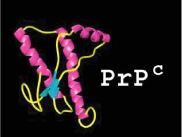

|
 |
 |

|
 |

|

|

|
 |

|
 |
New Findings
Concrete evidence to support the prion hypothesis
Castilla et al. 2005. In Vitro Generation of Infectious Scrapie Proteins. Cell, Vol. 121, 195–206, April 22, 2005.
Prions are unconventional infectious agents responsible for transmissible spongiform encephalopathy (TSE) diseases. They are thought to be composed exclusively of the protease-resistant prion protein (PrPres) that replicates in the body by inducing the misfolding of the cellular prion protein (PrPC). Although compelling evidence supports this hypothesis, generation of infectious prion particles in vitro has not been convincingly demonstrated. Here we show that PrPC/PrPres conversion can be mimicked in vitro by cyclic amplification of protein misfolding, resulting in indefinite amplification of PrPres. The in vitro-generated forms of PrPres share similar biochemical and structural properties with PrPres derived from sick brains. Inoculation of wild-type hamsters with in vitro-produced PrPres led to a scrapie disease identical to the illness produced by brain infectious material. These findings demonstrate that prions can be generated in vitro and provide strong evidence in support of the protein-only hypothesis of prion transmission.
Could infectious prions be distributed in a range of body tissues?
Cunningham et al. 2004. Distribution of Bovine Spongiform Encephalopathy in Greater Kudu. Emerging Infectious Diseases •www.cdc.gov/eid Vol. 10, No. 6, June 2004.
Contrary to findings in cattle with BSE in which the tissue distribution of infectivity is the most limited recorded for any of the transmissible spongiform encephalopathies (TSE), infectivity in greater kudu (Tragelaphus strepsiceros) with BSE is distributed in as wide a range of tissues as occurs in any TSE. BSE agent was also detected in skin, conjunctiva, and salivary gland, tissues in which infectivity has not previously been reported in any naturally occurring TSE. The distribution of infectivity in greater kudu with BSE suggests possible routes for transmission of the disease and highlights the need for further research into the distribution of TSE infectious agents in other host species.
Prions may be transmitted indirectly from the environment
Miller et al. 2004. Environmental Sources of Prion Transmission in Mule Deer. Emerging Infectious Diseases www.cdc.gov/eid Vol. 10, No. 6, June 2004
Chronic wasting disease, a prion disease affecting cervids, can be transmitted to susceptible animals indirectly, from environments contaminated by excreta or decomposed carcasses. Under experimental conditions, mule deer (Odocoileus hemionus) became infected in two of three paddocks containing naturally infected deer, in two of three paddocks where infected deer carcasses had decomposed 1.8 years earlier, and in one of three paddocks where infected deer had last resided 2.2 years earlier. Indirect transmission and environmental persistence of infectious prions will complicate efforts to control CWD and perhaps other animal prion diseases.
Could other animal TSEs pose a risk to humans?
Belay et al. 2004. Chronic Wasting Disease and Potential Transmission to Humans. Emerging Infectious Diseases Vol. 10, No. 6, June 2004, pg. 977-984.
Chronic wasting disease (CWD) of deer and elk is endemic in a tri-corner area of Colorado, Wyoming, and Nebraska, and new foci of CWD have been detected in other parts of the United States. Although detection in some areas may be related to increased surveillance, introduction of CWD due to translocation or natural migration of animals may account for some new foci of infection. Increasing spread of CWD has raised concerns about the potential for increasing human exposure to the CWD agent. The foodborne transmission of bovine spongiform encephalopathy to humans indicates that the species barrier may not completely protect humans from animal prion diseases. Conversion of human prion protein by CWDassociated prions has been demonstrated in an in vitro cell free experiment, but limited investigations have not identified strong evidence for CWD transmission to humans. More epidemiologic and laboratory studies are needed to monitor the possibility of such transmissions.
Zinc and Copper Required for Infectious Prion Replication
Nishina et al. 2004. Ionic Strength and Transition Metals Control PrP Sc Protease Resistance and Conversion-inducing Activity. The Journal of Biological Chemistry Vol. 279, No. 39. September 24, pp. 40788–40794, 2004
PrP molecules are structurally interconvertible and that only a subset of PrP Sc conformations are able to induce the conversion of other PrP molecules. The presence of zinc and copper ions is required for protease resistant conformations of PrPSc proteins to exist. The protease-sensitive and protease-resistant conformations of PrPSc are reversibly interchangeable, but only the protease-resistant conformation of PrPSc induced by high ionic strength was able to induce the formation of newprotease-resistant PrP (PrPres) molecules in vitro.
Review of Studies Demonstrating Genetic Susceptibility to Kuru
Goldfarb et al. 2004. Genetic Studies in Relation to Kuru: An Overview. Current Molecular Medicine 2004, 4, 375-384.
Recent studies indicate that individuals homozygous for Methionine at polymorphic position 129 of the prion protein were preferentially affected during the kuru epidemic of the 1950s. The carriers of the alternative 129Met/Val and 129Val/Val genotypes had a longer incubation period and thus developed disease at a later age and at a later stage of the epidemic. Observations made during the kuru epidemic may be helpful in understanding vCJD outbreaks.